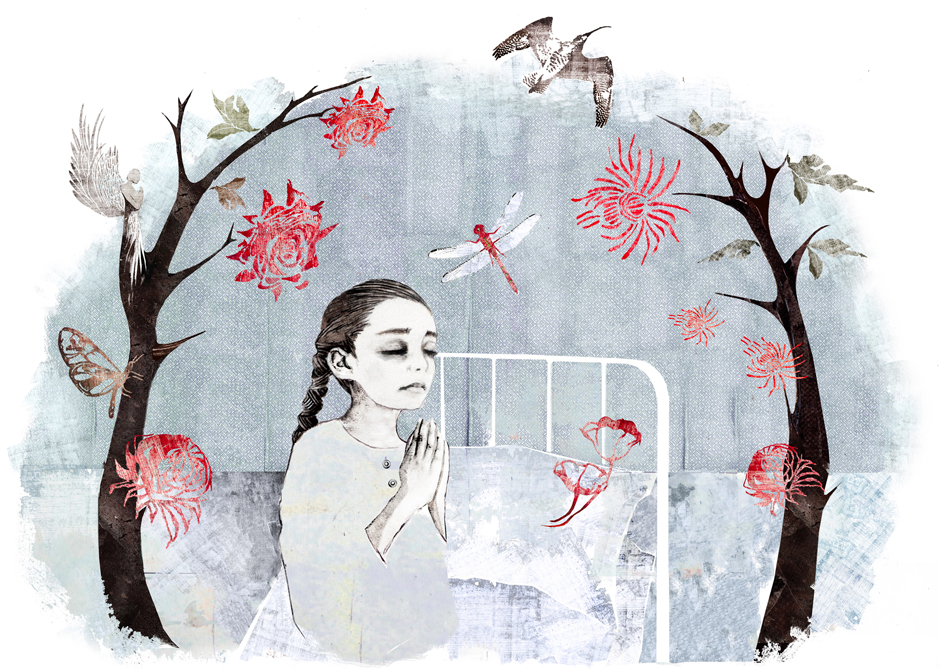
Auditory vocal hallucinations during adolescence: the role of spirituality and religiosity
In Western cultures, the phenomenon of hearing voices is often seen as an indicator of mental illness. However, did you know that hearing voices is actually quite common in the general population and does not necessarily indicate psychopathology? Similarly, the relation between hearing voices and religious practice is often perceived negatively by the general public as well. Most of us have at least once heard of a homicide reportedly committed under the influence of a religious delusion: “God told me to do it”. However, from a historical perspective, hearing voices was often seen as divine, and is still classified as such in many non-Western cultures. In this blog post I will describe the findings from my latest article (Steenhuis et al., 2016), which sought to clarify the relationship between religiosity and auditory vocal hallucinations during adolescence.
A hallucination is defined by the DSM-5 as a sensory perception without the external stimulation of the relevant sensory organ. Specifically auditory vocal hallucinations refer to perceptions of hearing people talk, whisper, scream, or mutter. These hallucinations are quite common in the general population. The reporting of hallucinations generally declines with age and mostly disappears over time. The prevalence rate of auditory vocal hallucinations in childhood varies from 8 to 9%, and of these children a small proportion may continue to hear voices during adolescence (23.5%; Bartels-Velthuis et al., 2011). Why do these hallucinations become persistent for some and not for others?
“In the general population, auditory vocal hallucinations are reported quite often by adults, adolescents, and children.”
Previous research has examined the role of religion in schizophrenia, demonstrating that religiosity is linked to a higher rate of hallucinatory experiences in adult samples (Mohr, Brandt, Borras, Gilliéron, & Huguelet, 2006). Explanations have ranged from the possibility that religion is utilized as a coping strategy, to the idea that religion promotes distorted perceptions and distrust of others (e.g. Mohr et al., 2006). Generally, adult patients seem to report that religion can have both positive influences (e.g., provides a resource for coping) and negative ones (e.g., aggravates the psychopathology) (Koenig, 2009).
“The consensus is that religion may have both a positive and negative effect on mental health and well-being in adults with schizophrenia.”
So what role does religiosity play in the reporting and development of auditory vocal hallucinations during adolescence? If religion offers a source of comfort, adolescents reporting auditory vocal hallucinations might be more likely to report religious activity as a method of coping. If religiosity is experienced negatively, i.e. as a ‘spiritual struggle’, it could also aggravate hallucinatory experiences. During my PhD project I explored these ideas. One of my supervisors, Dr. Agna Bartels-Velthuis, had followed-up a sample of 337 young Dutch adolescents aged 12-13 years, of whom baseline data was available from about five years earlier (Bartels-Velthuis, Jenner, van de Willige, van Os, & Wiersma, 2010; Bartels-Velthuis et al., 2011). All adolescents were interviewed at follow-up and their level of self-reported religiosity was examined in relation to the reporting of auditory verbal hallucinations. For those who reported hallucinations, the course, valence, and severity of their auditory vocal hallucinations was also examined in relation to religiosity.
Our results showed that cross-sectionally, moderately religious adolescents were more likely to report auditory vocal hallucinations in comparison to both non-religious adolescents and strongly religious adolescents (Steenhuis et al., 2016). Longitudinally, the moderately religious adolescents were also more likely to have recently developed auditory vocal hallucinations between baseline and follow-up. At first these results seemed puzzling. Why are moderately religious adolescents likely to report auditory vocal hallucinations?
“Religious beliefs were most often described as supportive and useful, for both adolescents with and without auditory vocal hallucinations”
On further analysis of the data, we found that many adolescents reporting hallucinatory experiences had positive voices and described their religious beliefs as supportive, useful, or neutral. Therefore, the hypothesis that religiosity could aggravate hallucinatory experiences was not supported. In addition, while most adolescents who were moderately religious and reported hallucinatory experiences believed in and practiced some sort of religion or spirituality, they were often not raised with religion nor belonged to a religious community. It is possible that moderately religious adolescents who heard voices adopted specific religious practices and beliefs as a method of coping with hallucinations. Additionally, strongly religious adolescents may have been protected by the positive impact of religion, as they not only believed in and practiced religion, they also belonged to a religious community and were raised religiously. This idea is supported by prior studies demonstrating that strong religious beliefs and practices can protect adolescents from substance abuse, anxiety, and depressive symptoms (e.g. Pearce et al., 2003).
“Religiosity may be utilized positively, as a method of appraising, and coping with, the hallucinatory experiences”
In short, religiosity appears to play a positive and supportive role for adolescents in the general population who report auditory vocal hallucinations. There are two important messages to take home. First: hallucinations do not necessarily signify a mental disorder. Second: religion and spiritual practices may be helpful in coping with mental health issues of any nature.
References:
Bartels-Velthuis, A. A., Jenner, J. A., van de Willige, G., van Os, J., & Wiersma, D. (2010). Prevalence and correlates of auditory vocal hallucinations in middle childhood. British Journal of Psychiatry, 196(1), 41–6.
Bartels-Velthuis, A. A., van de Willige, G., Jenner, J. A., van Os, J., & Wiersma, D. (2011). Course of auditory vocal hallucinations in childhood: 5-year follow-up study. British Journal of Psychiatry, 199(4), 296–302.
Koenig, H. G. (2009). Research on religion, spirituality, and mental health: a review. Canadian Journal of Psychiatry, 54, 283–291.
Mohr, S., Brandt, P., Borras, L., Gilliéron, C., & Huguelet, P. (2006). Toward an Integration of Spirituality and Religiousness Into the Psychosocial Dimension of Schizophrenia. American Journal of Psychiatry, 163(11), 1952–1959.
Pearce, M. J., Little, T. D., & Perez, J. E. (2003). Religiousness and Depressive Symptoms Among Adolescents. Journal of Clinical Child & Adolescent Psychology, 32, 267–276.
Steenhuis, L. A., Bartels-Velthuis, A. A., Jenner, J. A., Aleman, A., Bruggeman, R., Nauta, M. H., & Pijnenborg, G. H. M. (2016). Religiosity in young adolescents with auditory vocal hallucinations. Psychiatry Research, 236, 158–164.
NOTE: Image by Elin Karsnes, permission to use obtained by LS.



